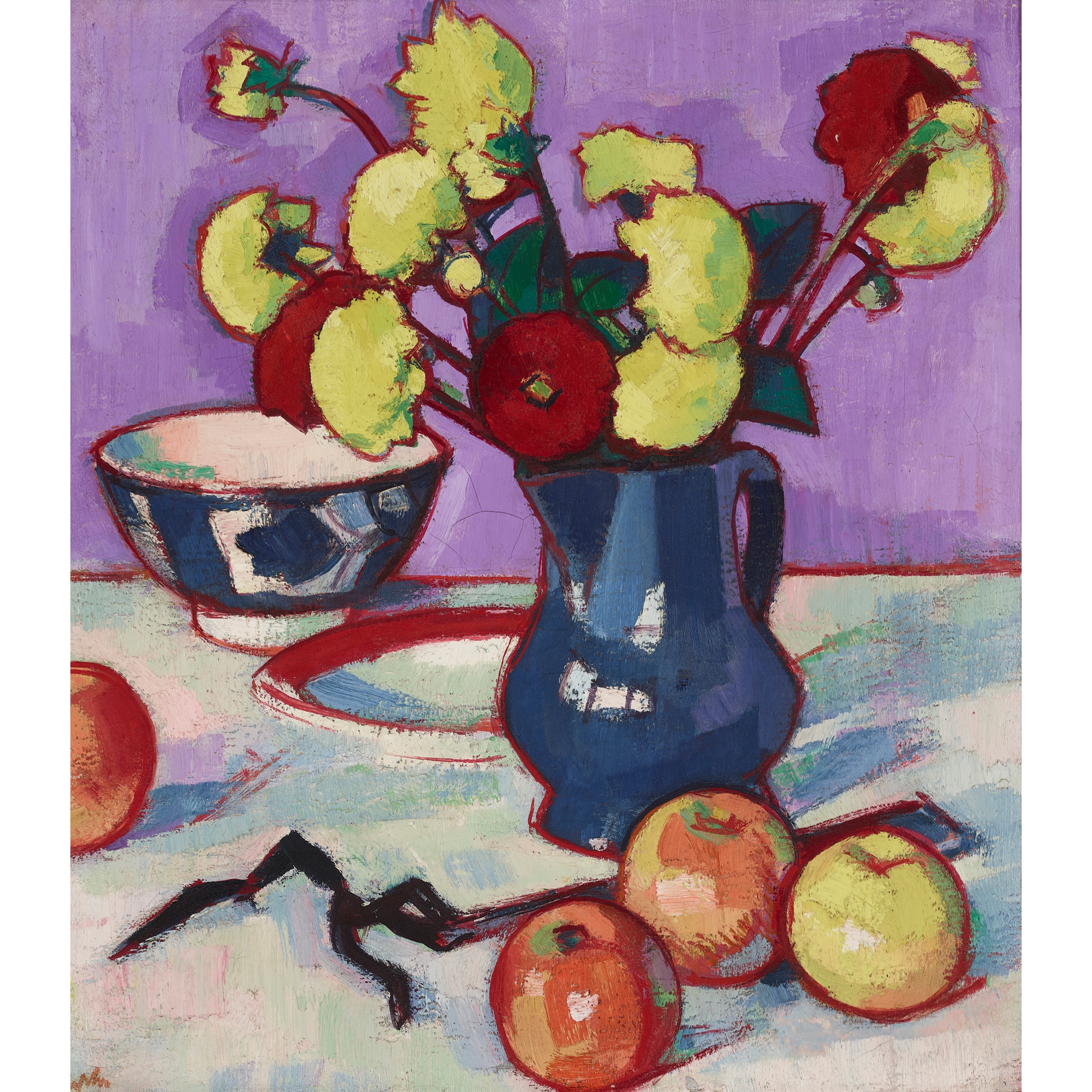SAMUEL JOHN PEPLOE R.S.A. (SCOTTISH 1871-1935)
STILL LIFE WITH FRUIT AND FLOWERS
£425,201
Scottish Paintings & Sculpture
Auction: Evening Sale: Lots 100 to 191 | 06 June 2024 at 6pm
Description
Signed, oil on canvas
Dimensions
46cm x 41cm (18in x 16in)
Provenance
Ian MacNicol, Glasgow
Footnote
Exhibited: McLellan Galleries, Glasgow, Memorial Exhibition of Paintings by S .J. Peploe RSA, February 1937
Still Life with Fruit and Flowers is an exceptional painting: it was created when Peploe was working most closely with his friend and fellow Scottish Colourist F. C. B. Cadell, and is in the still life genre for which he is most celebrated. Its stunning palette, cropped and asymmetrical composition, and frank technique mean that it encapsulates the ‘modern’ in modern Scottish art. It is on such bold works that Peploe’s leading reputation within twentieth-century art history is based.
Peploe and Cadell had met in Edinburgh by 1909 and both received their second solo exhibitions at The Scottish Gallery in the capital the following year. They stayed in touch during Peploe’s sojourn in Paris from 1910 until 1912 and whilst Cadell saw active service during World War One. Following his demobilisation in 1919, Cadell moved to 6 Ainslie Place in Edinburgh’s New Town, a few minutes’ walk from Peploe’s home at 13 India Street and studio at 54 Shandwick Place.
The artists’ friendship intensified and their working relationship became closer. Still Life with Fruit and Flowers shows how they even shared a taste for props, such as the orange-rimmed plate, be-ribboned black fan and blue-glazed jug, the likes of which also appeared in Cadell’s contemporary paintings. The stunning lilac background which is such a feature of the present work is surely a direct reference to the colour with which Cadell painted the first floor at Ainslie Place. As T. J. Honeyman recorded: “Cadell’s studio was about the only one S. J. [sic] ever visited. They often criticised each other’s work, suggesting an improvement here and there, counselling eliminations of some passage or advising a fresh attempt.” (T. J. Honeyman, Three Scottish Colourists, London, 1950, p.66)
The still life genre was of the utmost important to Peploe throughout his career. He first emerged as an artist of importance at his inaugural solo exhibition in 1903 with a series of still lifes realised in thick, creamy paint, set before a dark background and full of implied narratives of a sophisticated lifestyle. The time he spent in Paris before the War changed his work dramatically, as he submerged himself in the very latest developments in French art, from Cubism to Fauvism. With a medical exemption from war service, Peploe used the years of the conflict for development and exploration, including of the work of Paul Cézanne.
Elizabeth Cumming has explained the importance of Peploe’s post-war still lifes, writing:
“The end of the war seems to have spurred him to embark on a new series of brightly coloured flower paintings, integrating his unapologetic new academicism with his confidence of colour. The result spelt modernity. Despite his increasing fascination with Cézanne, Peploe was remaining loyal to the decorative values set out by Matisse…Such carefully orchestrated blasts of colour were extraordinary…As [the collector Ion] Harrison recalled thirty years later ‘I had never seen anything in art similar to these pictures and I did not understand them. They really startled me for, to my eyes, they were so ultra-modern.’” (Elizabeth Cumming, ‘Exploring the Poetics of Form: the Post-war Paintings of S. J. Peploe’ in Alice Strang et al, S. J. Peploe, National Galleries of Edinburgh, 2012, p.68)
Peploe’s paintstaking working process, by which he would arrange and re-arrange his props for sometimes days on end, resulted in the perfect pitch of inter-relationships between form and colour seen in Still Life with Fruit and Flowers. The focal point of the loosely arranged flowers in the jug makes the most of the yellow and red of the flowerheads, and their profiles, against the lilac background. The rounded form of the jug, in whose surface the windows behind the artist are reflected, anchors the composition. The cropping and overlaying of elements, from fruit on the left, to the run of bowl to plate and jug, provides rhythmic stops and fluid sightlines over the image. Peploe’s enjoyment of realising curved volume is clear in the apples in the foreground, whilst the light entering the scene from the lower left casts deftly rendered shadows that lead the eye to the right and beyond the canvas.
Still Life with Fruit and Flowers can be considered the triumphant result of some twenty years of dedication and courageous experimentation in the genre, about which Peploe was to declare in 1929: “There is so much in mere objects, flowers, leaves, jugs, what not – colours, forms, relation – I can never see mystery coming to an end.” (quoted in Stanley Cursiter, Peploe: An Intimate Memoir of an Artist and of his Work, Thomas Nelson and Sons Ltd, Edinburgh, 1947, p.73). It was selected for inclusion in the memorial exhibition of Peploe’s work mounted at the McLellan Galleries, Glasgow in 1937, following the artist’s death in Edinburgh in 1935.

